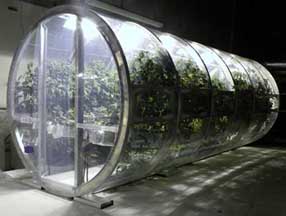

Phase I

Objectives
- Determine the food production capability (kg per unit area per unit time)
- Determine the water balance (liquid irrigation water, biomass and water vapor)
- Determine the carbon balance (gaseous carbon dioxide and biomass)
- Determine the energy to radiation balance (electrical power and lamp output)
- Document the system operational requirements, capabilities and weaknesses, while demonstrating the innovative Cable Culture plant growing system by producing a combination of targeted NASA crops (lettuce greens, cucumber, sweet potato, and strawberry)
Deliverables
- Provide plant production characteristics, including fresh and dry weights per unit time, volume, and input resources, as well as, a subjective accounting of plant quality, and; demonstrate consistent and predictable growth of NASA crops within the LGH poly-culture system.
[Patterson1, Sadler2, Giacomelli2] - Determine the degree of system fidelity by monitoring and accounting for the flows of consumables including electrical energy, carbon dioxide, water, and labor, transformed into targeted products and byproducts, including PAR, heat, biomass, water vapor and oxygen.
[Patterson1, Kacira1, Furfaro2, Giacomelli2] - Prepare recommended improvements of the existing LGH modular system, necessary to increase system fidelity, and for implementation of Phase II hardware. Propose improvements for control, resource recovery, cover materials, plant poly-culture.
[Furfaro1, Sadler1, Kacira1, Patterson1, Giacomelli1] - Outline the telepresence techniques for monitoring and analysis using web camera, sensors, Internet and remote stations for determining real-time plant nominal conditions, establish telepresence techniques for a public portal to demonstrate capabilities of the food production, water and atmosphere revitalization and generate interest in future Lunar science outpost missions. Outreach with telepresence technology to NASA (STEM), Land-Grant and CEAC stakeholders.
[Kacira1, Giacomelli1, Barto2, Patterson2, Furfaro2]
(1primary; 2support)


© 2009-2013 UA-CEAC
Created by David StoryManaged by Story, Kacira, and Giacomelli